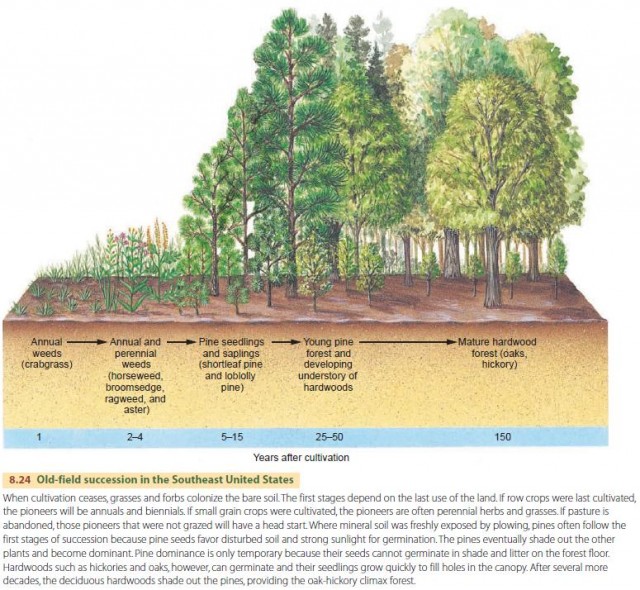Ecological Succession
Plant and animal communities change through time. Walk through the country and you'll see patches of vegetation in many stages of development—from open, cultivated fields through grassy shrublands to forests. Clear lakes gradually fill with sediment and become bogs. We call these changes—in which biotic communities succeed one another on the way to a stable end point—ecological succession.
In general, succession forms the most complex community of organisms possible, given its physical conditions of the area. The series of communities that follow one another is called a sere. Each of the temporary communities is referred to as a seral stage. The stable community, which is the end point of succession, is the climax. If succession begins on a newly constructed deposit of mineral sediment, it is called primary succession. If, on the other hand, succession occurs on a previously vegetated area that has been recently disturbed, perhaps by fire, flood, windstorm, or human activity, it is referred to as secondary succession.
Primary succession could happen on a sand dune, a sand beach, the surface of a new lava flow or freshly fallen layer of volcanic ash, or the deposits of silt on the inside of a river bend that is gradually shifting, for example. Such sites are often little more than deposits of coarse mineral fragments. In other cases—floodplain silt deposits, for example—the surface layer is made of redeposited soil, with substantial amounts of organic matter and nutrients.
Succession begins with the pioneer stage. It includes a few plant and animal pioneers that are unusually well adapted to otherwise inhospitable conditions that may be caused by rapid water drainage, dry soil, excessive sunlight exposure, wind, or extreme ground and lower air temperatures. As pioneer plants grow, their roots penetrate the soil. When the plants decay, their roots add organic matter directly to the soil, while their fallen leaves and stems add an organic layer to the ground surface. Large numbers of bacteria and invertebrates begin to live in the soil. Grazing mammals feed on the small plants and birds forage the newly vegetated area for seeds and grubs.
The pioneers soon transform conditions, making them favorable for other species that invade the area and displace the pioneers. The new arrivals may be larger plants with foliage that covers the ground more extensively. If this happens, the climate near the ground will have less extreme air and soil temperatures, higher humidity, and less intense insolation. These changes allow still other species to invade and thrive. When the succession has finally run its course, a climax community of plant and animal species in a more or less stable composition will have been established.
Sand dune colonization is a good example of primary succession. Animal species also change as succession proceeds. This is especially noticeable in the insects and invertebrates, which go from sand spiders and grasshoppers on the open dunes to sowbugs and earthworms in the dune forest.
Secondary succession can occur after a disturbance alters an existing community. Old-field succession, taking place on abandoned farmland, is a good example of secondary succession (Figure 8.24).

SUCCESSION, CHANGE, AND EQUILIBRIUM
So far, we've been describing successional changes caused by the actions of the plants and animals themselves. One set of inhabitants paves the way for the next. As long as nearby populations of species provide colonizers, the changes lead automatically from bare soil or fallow field to climax forest. This type is called autogenic (selfproducing) succession.
But in many cases, autogenic succession does not run its full course. Environmental disturbances, such as wind, fire, flood, or clearing for agriculture interrupt succession temporarily or even permanently.
For example, winds and waves can disturb autogenic succession on seaside dunes, or a mature forest may be destroyed by fire. In addition, inhospitable habitat conditions such as site exposure, unusual bedrock, or impeded drainage can hold back or divert the course of succession so successfully that the climax is never reached.
Introducing a new species can also greatly alter existing ecosystems and successional pathways. The parasitic chestnut blight fungus was introduced from Asia to New York City in 1904. From there, it spread across the eastern states, decimating populations of the American chestnut tree within a period of about 40 years. This tree species, which may have accounted for as many as one-fourth of the mature trees in eastern forests, is now found only as small blighted stems sprouting from old root systems.
While succession is a reasonable model to explain many of the changes that we see in ecosystems with time, we must also take into account other effects. External forces can reverse or rechannel autogenic change temporarily or permanently. The biotic landscape is a mosaic of distinctive biotic communities with different biological potentials and different histories.